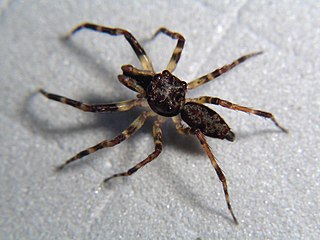
Allococalodes is a genus of Papuan jumping spiders that was first described by F. R. Wanless in 1982. As of June 2019 it contains only three species, found only in Papua New Guinea: A. alticeps, A. cornutus, and A. madidus. The name is a combination of Ancient Greek ἄλλος, meaning "other", and the genus Cocalodes.
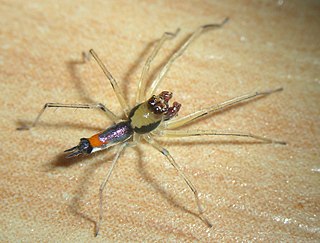
Asemonea is a genus of jumping spiders that was first described by Octavius Pickard-Cambridge in 1869.
Athamas is a genus of jumping spiders that was first described by Octavius Pickard-Cambridge in 1877. The name is derived from Athamas, the king of Orchomenus in Greek mythology.
Bulolia is a genus of Papuan jumping spiders that was first described by Marek Michał Żabka in 1996. As of June 2019 it contains only two species, found only in Papua New Guinea: B. excentrica and B. ocellata.

Diolenius is a genus of jumping spiders that was first described by Tamerlan Thorell in 1870.
Goleba is a genus of African jumping spiders that was first described by F. R. Wanless in 1980.
Leptathamas is a spider genus of the jumping spider family, Salticidae, with one described species, which occurs only in New Guinea.
Saraina is a spider genus of the jumping spider family, Salticidae, found in Africa.
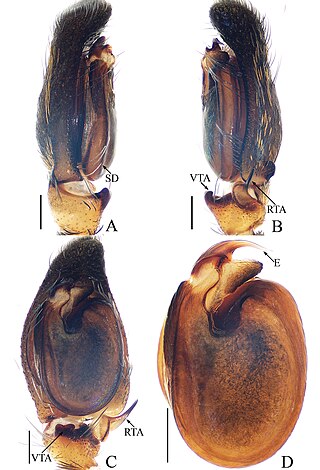
Gelotia is a genus of jumping spiders that was first described by Tamerlan Thorell in 1890.
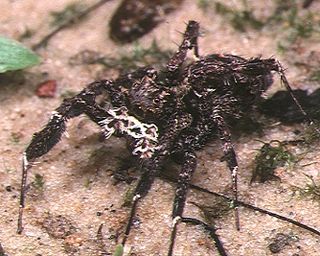
The Spartaeinae are a subfamily of the spider family Salticidae. The subfamily was established by Fred R. Wanless in 1984 to include the groups Boetheae, Cocaleae, Lineae, Codeteae and Cyrbeae, which in turn were defined by Eugène Simon.

Ohilimia is a spider genus of the jumping spider family, Salticidae.

Wanda Wesołowska is a Polish zoologist known for her work with jumping spiders. She has described more species of jumping spider than any contemporary writer, and is second only to Eugène Simon in the history of arachnology. Originally a student of ornithology, she developed an interest in jumping spiders while still a student at the Siedlce University of Natural Sciences and Humanities in the 1970s.

Asemonea virgea is a species of jumping spider in the genus Asemonea that is endemic to the Republic of the Congo. The spider was first described in 2003 by Wanda Wesołowska and Tamás Szűts. The spider is small, with a dark yellow carapace typically 1.6 mm (0.063 in) long and an abdomen 1.8 mm (0.071 in) long. The male has a distinctive set of spines on its palpal tibia, after which it is named. It is similar to the related Asemonea cristata but differs in its species range, as the other spider is found in Burma, and its shorter femoral apophysis. The female has not been described.
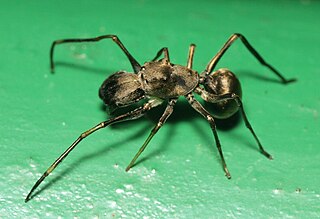
Toxeus is a genus of jumping spiders first described by Carl Ludwig Koch in 1846. The genus was synonymized with Myrmarachne by Eugène Simon in 1901, and remained a synonym until revived by Jerzy Prószyński in 2016, when he split up Myrmarachne.
Fred R. Wanless was a British arachnologist. Active in the field especially in the seventies and eighties of the 20th century, he described several dozen taxa, in particular among the spiders of the Salticidae family. Wanless played a significant role in the British Arachnological Society being its member in 1969–1973, 1974–1976 and 1986–1989, and Meetings Secretary in 1973–1978. From 1973 to 1988 he described 137 new species and 13 new genera.

Agorioides is a small genus of Melanesian jumping spiders. It was first described by Wayne Maddison and T. Szűts in 2019, and it has only been found in Papua New Guinea. It is placed in the tribe Myrmarachnini, part of the Salticoida clade of the subfamily Salticinae in Wayne Maddison's 2015 classification of the jumping spiders. As of March 2022 it contains only two species: A. cherubino and A. papagena.

Leviea is a genus of Melanesian jumping spiders. It was first described by Wayne Maddison and T. Szűts in 2019, and As of March 2022 it contains only three species: L. francesae, L. herberti, and L. lornae. The genus name and species epithets honor arachnologists Herbert Walter Levi and his wife Lorna Rose Levi as well as their daughter Frances Levi.
Papuamyr is a small genus of Melanesian jumping spiders native to Papua New Guinea. The genus was erected by Wayne Maddison and T. Szűts in 2019, and was placed into the tribe Myrmarachnini, within the Salticoida clade of Salticinae. As of April 2022 it contains only two species: P. omhifosga and P. pandora.

Asemonea stella is a species of jumping spider in the genus Asemonea that lives in Kenya, South Africa and Tanzania, and has been introduced to Australia. It thrives in a wide range of environments, from open farmland to semi-aquatic vegetation. The spider was first defined in 1980 by Fred Wanless. The spider is small, between 3.1 and 3.64 mm long, the female being generally larger than the male. It has a carapace that is pear-shaped and either yellow in the case of the male or green in the case of the female, measuring between 1.28 and 1.46 mm in length.The abdomen is whiter, between 1.28 and 1.46 mm long and has a distinctive star-shaped pattern on the back. Its copulatory organs help differentiate the species, particularly the furrow on the femoral apophysis of the male palpal bulb and the shallow depression in the middle of the female epigyne.











